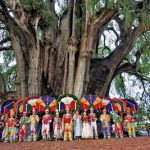I Live In Ajijic
By Neill James

Ajijic is an old, old village. Our solidly built Franciscan Church bears the date when it was finished: November 27, 1749. But it is not the original. The first was destroyed by a hurricane. Even before that, before the Conquistadores set foot on the shores of the New World, Ajijic was an Indian settlement. Ancestors of my neighbors gained a comfortable livelihood fishing in the lake and cultivating their milpas. Long after the Spaniards had planted a new religion, Indians continued to make their little clay figurines, bake them, and toss them into the lake to appease Tlaloc, their Rain God. Often we foreigners amuse ourselves diving for these exotic little figurines which we use to decorate our homes.
Foreigners of many nationalities come to Ajijic by design. Otherwise they’d never find the village hidden among tall green-black mango trees, squeezed in between the green mountains and the lake. Only two new houses, one built by a Mexican Colonel and the other by an English refugee couple, break the natural mild contour of the grassy shore. These estates and the tall stark white unfinished alfeñique tower of the church jutting above the tree tops sharply silhouetted against the hills serve as landmarks for the settlement when approached by boat. Compared with places outside Mexico, Ajijic with its peaceful inhabitants and climate of perpetual Indian Summer, is a little bit of heaven.
The Lake’s natural shore line with droopy willows standing ankle deep in water, and gray-green eucalyptus alive with bees, nets drying in the sun, fishermen leisurely drawing in a graceful loop of floaters and women using the 75 kilometer by 25 kilometer lake as a washtub have caught the fancy of more than one visiting artist.
Villagers lead modest dignified lives governed to a degree by the spirit of mañana. We have hospices where a stranger may find lodging; we have a posada, a casa de asistencia, and even a hotel, but none of the inn keepers trouble themselves to display a sign indicating the nature of their establishment. No need for grocery stores to display names either. Everybody knows where they are. And the Post Office, too. Only the foreigners come daily for their mail. Sometimes when the courier forgets and permits the Ajijic mail pouch to remain on the bus and continue on to Jocotepec, foreigners howl as if the oversight were a personal affront. Our streets have names but no one knows what they are. Our letters arrive marked simply “The House is known.”
Village children are plump and well-nourished, and we have only an occasional beggar, usually a man from elsewhere. Jalisco is one of the Republic’s richest agriculturist states, and the Lake Chapala region is especially favored. Mango, papaya, bananas, maiz, frijoles, chile, and jitomates form the main crops, but vegetables and fruits of almost every climate will grow in the local gardens. We have plums, peaches, lemons, oranges, grapefruit, apples, pomegranates, zapotes and many others. And at certain harvest seasons section of the village sidewalks are completely spread with drying peanuts, bean pods or ripe maiz, usually guarded by a girl nursing a baby or a woman engaged in needlework, against depredations of pigs, burros or cattle.
Our animals lead a free life and when venturing abroad on a dark night there is always the danger of stumbling headlong over a black cow or pig sleeping in the street, or crashing into the rear of a burro. Foreigners carry flashlights, Mexicans look where they’re going.
Our Dry Season is really dry and the Rainy Season very wet. However, Tlaloc, our Rain God, is considerate and the tropical downpours which usually blow in with sudden strong gusts of wind come at night when everyone is asleep. I prefer the rainy days when tender young mushrooms spring up like giant snowdrops in the corrals, and the orchids clinging to boles of leafy trees in the valleys swell to flower. Then the atmosphere is crystal clear and the sunsets of the lake a marvel to behold. An occasional urchin clad in blue denim overalls and a wide brimmed sombrero can often be seen ambling along the street swinging a stem of the luxury flowers worth $25.00 in another locale. Many families have a few orchids growing on orange trees in patio or garden.
Our trees shaded central plaza is the scene of many fiestas complete with fireworks, music and serenatas. The latter is a happy occasion when the boys and girls stroll about the plaza in opposite directions and flirt with flowers, with a musical background, frequently in the moonlight.
Artists, writers and foreign vacationers arrive by launch, struggle ashore to spend the day for a brief glimpse of Ajijic. Many return to paint or write. Lack of a dock has been a serious handicap to lake-borne traffic, and a poor road has hampered land travelers, and happily contributed to our isolation. All this will end soon.
Already an engineer is in our midst rushing work to completion on a new 30,000 pesos dock. Launches formerly unable to dock now will kill their engines, pole cautiously, rest the gang plank on the half-finished rock and concrete pier; and passengers walk ashore with dry feet. Thus Art and Isolation must bow to Progress and Transportation.
- April 2024 – Issue - March 31, 2024
- April 2024 – Articles - March 31, 2024
- April 2024 - March 31, 2024








